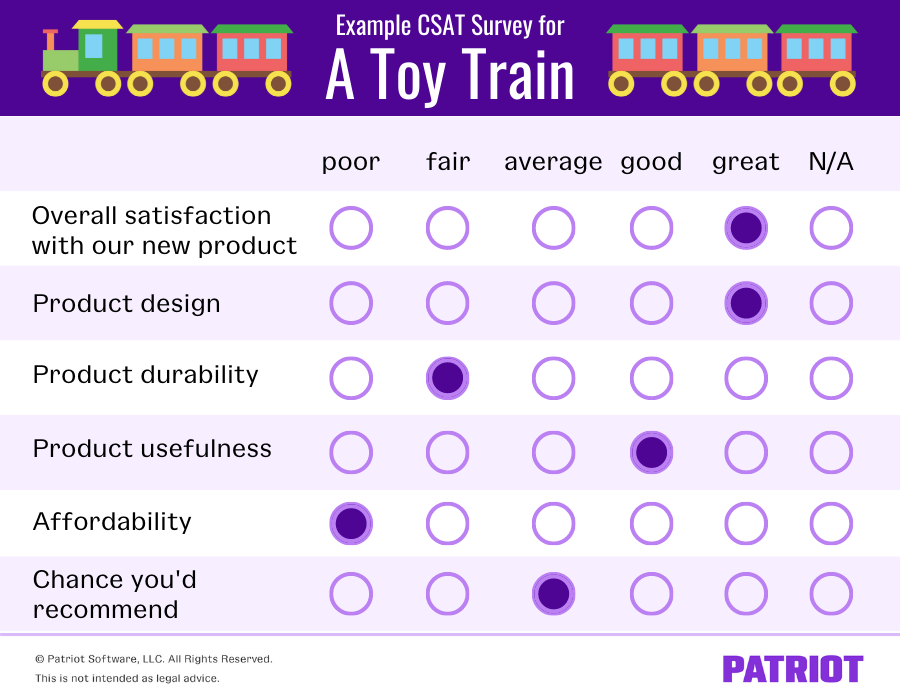With all the choices that customers have, keeping them happy is more important than ever. Unhappy customers may leave for other businesses and/or give you negative reviews online. Customer satisfaction scores, or CSAT scores, are a quick and easy way to check in with your customers and see how they feel about your business or specific offerings. CSAT surveys are easy to give, and the scores are easy to understand.
Read on for everything you need to know about CSAT scores and surveys.
What is CSAT?
CSAT stands for customer satisfaction index score. You can gather CSATs through customer satisfaction surveys. CSAT scores are simple metrics to understand how your customers feel about your business or a specific interaction they’ve had. If a company asks you to rate your experience on a scale of 1 – 5, you’ve come across a CSAT survey. The number you choose is your CSAT score for the company.
Depending on how the person taking the survey answers, the company knows if things are going well or if something needs to change.
Use CSAT surveys and scores to keep up with your customers and catch small problems before they get out of control.
How does a CSAT score help?
CSAT scores are helpful for several reasons, key among them is their ease of use. Other positive aspects of CSAT scores are that they are:
- Easy to capture. CSAT scores come from simple surveys asked at the right time. If you want to know how a customer feels about a specific product, ask them how they feel as soon as they’re done using it so their emotions are still fresh. If you’d like to know about a recent marketing campaign, think about waiting a few weeks so the campaign can run its course. A good rule of thumb is to use CSAT surveys when a specific part of the customer’s lifecycle is complete. That way, your CSAT will be timely and trustworthy.
- Simple for your customers to take. Customer satisfaction surveys are easy for customers to understand and answer honestly. Make sure that you are asking the right questions and using straightforward language.
- Common. You might be new to creating a CSAT survey and worrying about CSAT scores, but your customers aren’t new to taking them. Customer satisfaction surveys are already part of a customer’s life, so use them to your advantage. And, don’t be shy about getting to know what your customers think!
How do CSAT surveys and scores work?
Customer surveys are made up of the questions you ask and the number of answers you offer. The number of questions and possible answers is entirely up to you.
Customer surveys
Customer surveys can be a single question or can include multiple questions. But, keep in mind that certain survey lengths may be better than others.
A five-question survey may be too long for a customer who just finished shopping on your website. But, five questions might be the perfect amount once the customer has spent more time with your company. Customer context is key.
Customer survey scores
The answers you allow the customer to choose make up your score. You can allow as many possibilities as you’d like. A scale of 1 – 5 is most common, but 1 – 10 can also work well.
Here’s an example of a single-question survey with a scale of 1 – 5:
How satisfied are you with our product?
- Very unsatisfied
- Unsatisfied
- Neutral
- Satisfied
- Very satisfied
Calculating your score
Understanding the customer satisfaction score is simple. To calculate a score, you’ll first have to find the total number of your positive responses. In general, a positive score is any number above the median, or middle number.
In our survey example above, the scale is 1 – 5. The median of the scale is 3, which leaves 4 and 5 as positive responses. Next, divide your positive responses by the total number of responses, then multiply that by 100. The number you’re left with is the overall percentage of satisfied customers.
To see how this works in action, imagine that you have a total of 98 completed surveys. Of that number, 72 are positive (scoring four or five).
Here’s how to calculate your score:
(72 / 98) X 100 = 73.5%
At 73.5%, it’s easy to see that a majority of your customers are satisfied with your product. But, 73.5% might also be too low for comfort. The average customer satisfaction score for your industry may be 80%, proving that you are behind the pack. Or, you could have higher standards than your industry’s average for your CSAT.
The great thing about CSATs is once you have the information, you can act on it.
Examples of a CSAT
More often than not, you’ve seen CSAT surveys that ask a simple question like “How satisfied are you with __________?” While this can be a great way to understand customer satisfaction, you may want to consider using longer surveys with multiple questions.
Different surveys will work better for different moments in the customer lifecycle. How you construct your survey may also depend on the information you want to know.
Imagine that you’ve launched a new toy train that was a big departure for your company. While sales are good, you still want a better understanding of how your customers feel about the new toy. You may come up with a customer survey that looks like this:

At first glance, you can easily see that this customer thought the toy train was too expensive and that it could have been more durable. Otherwise, your toy has a positive review. Your customer chose “great” to describe their overall satisfaction and the toy’s design.
Calculate the score of a multiple-answer survey the same way you would a survey with only one question. Look at each answer individually and score it against answers from the same category. For the above example, each answer offers a unique data set for you to look at.
If this survey was sent out to 100 customers, the average breakdown could look like this:
- Overall satisfaction with our new product: 80%
- Product design: 90%
- Product durability: 85%
- Product affordability: 50%
- Chance you’d recommend: 50%
Again, overall customer satisfaction is high. But if you were hoping for customers to recommend your toy train, you may be out of luck. There’s a chance that the toy’s price is too high.
If customers continue to think that the toy is too expensive and aren’t super excited about recommending it, you may decide that there’s something you need to change.
Other scores to rate customer experience
CSATs aren’t the only way to take the pulse of your customers. Net Promoter Scores (NPS) and Customer Effect Score (CES) can also help you understand your customers.
A Net Promoter Score measures how loyal customers are to your business. NPS surveys are usually one question and deal with the general reaction to your company. An NPS survey may sound something like this “Would you recommend our company to a friend?” with answers varying from “definitely not” to “absolutely.”
A Customer Effect Score measures how easy it was for a customer to interact with an aspect of your company (e.g., customer services, a product you offer, or a web user experience). Use a CES whenever the ease of customer experience is your top priority.
Want to impress your friends at a dinner party?
Get the latest small business news delivered straight to your inbox.
Subscribe to Email ListThis is not intended as legal advice; for more information, please click here.



